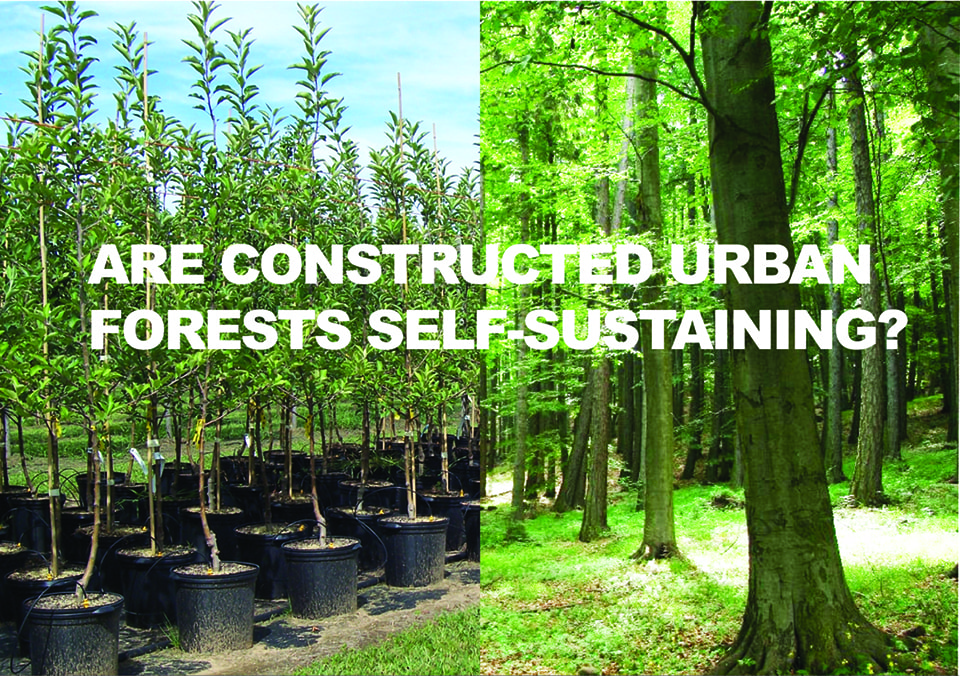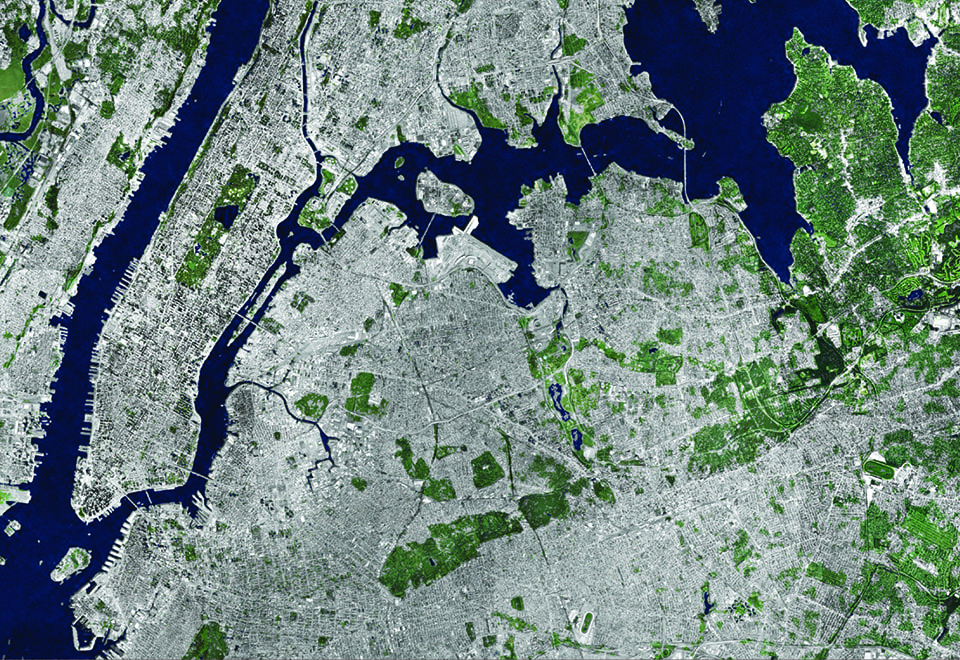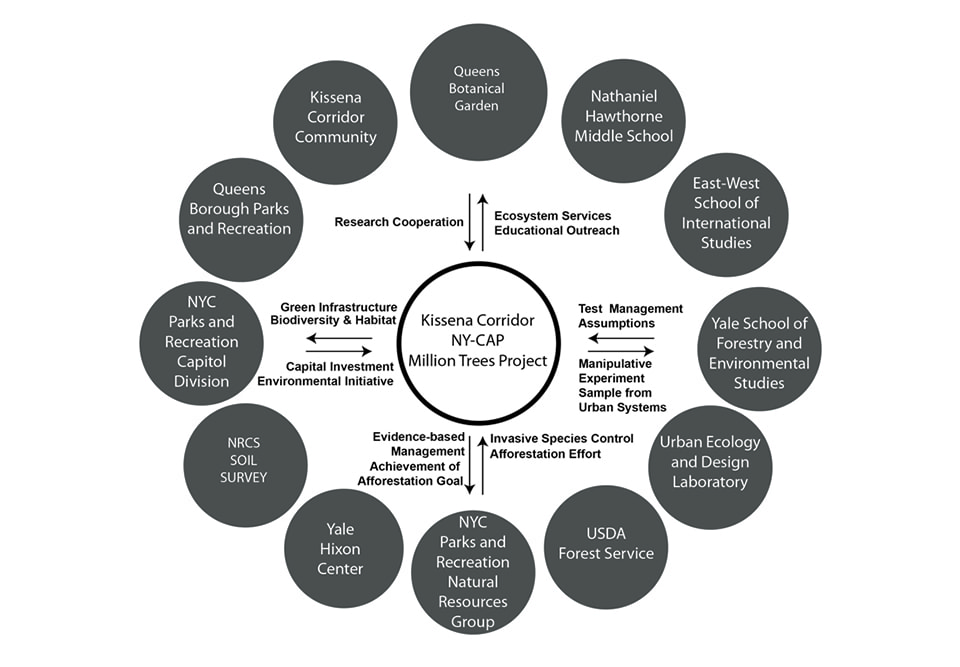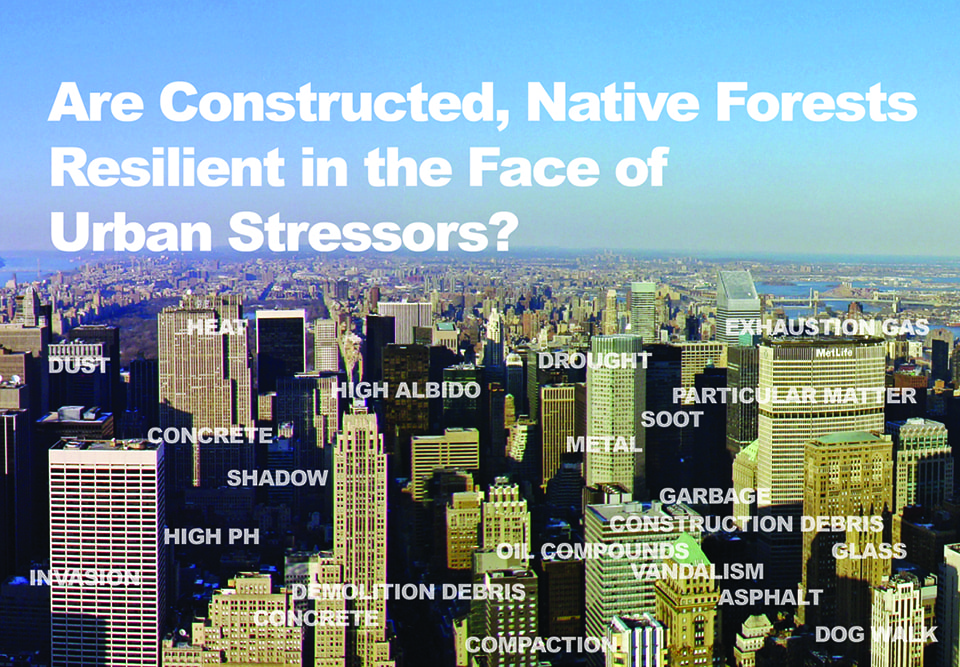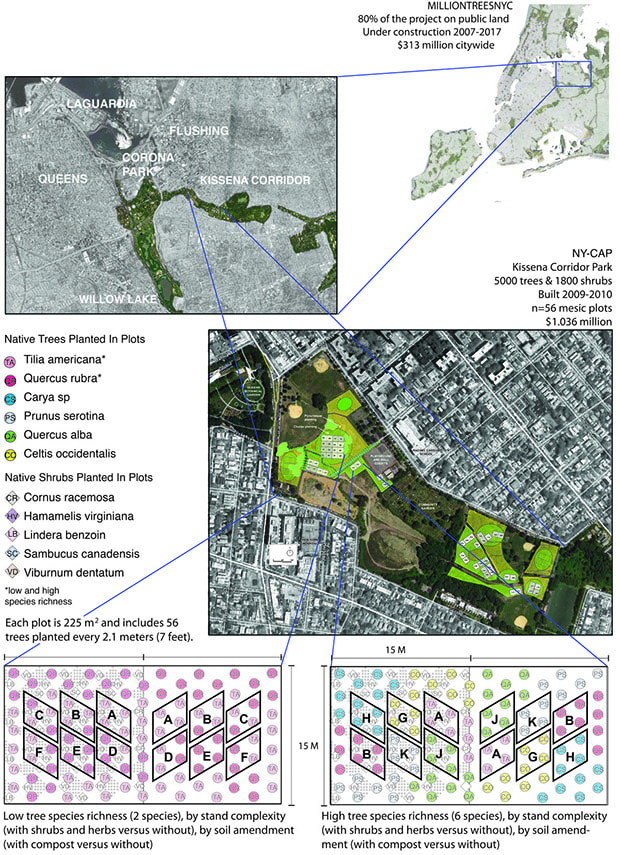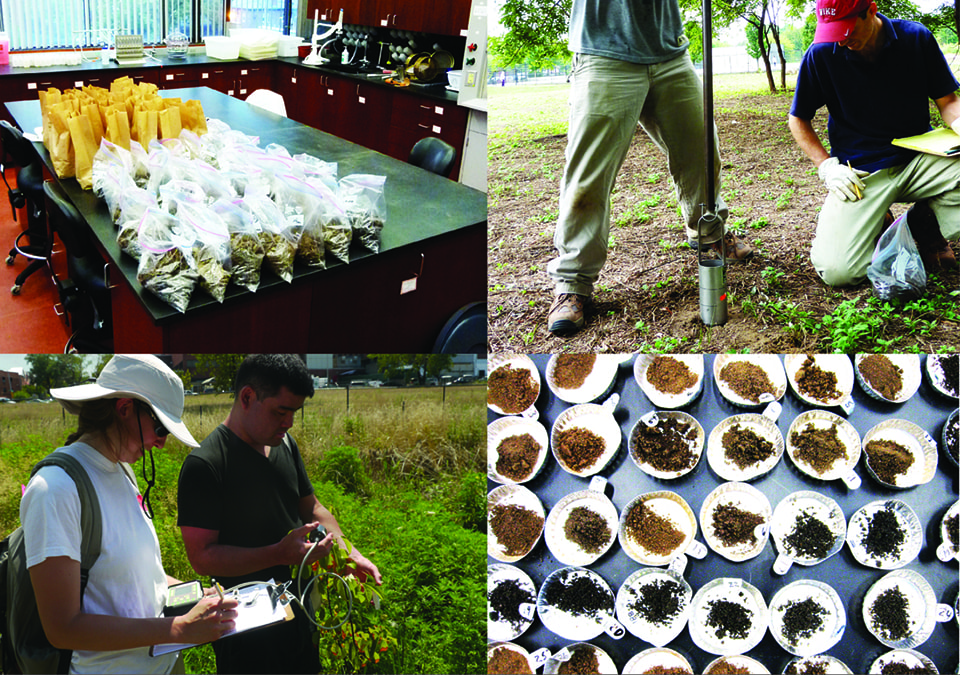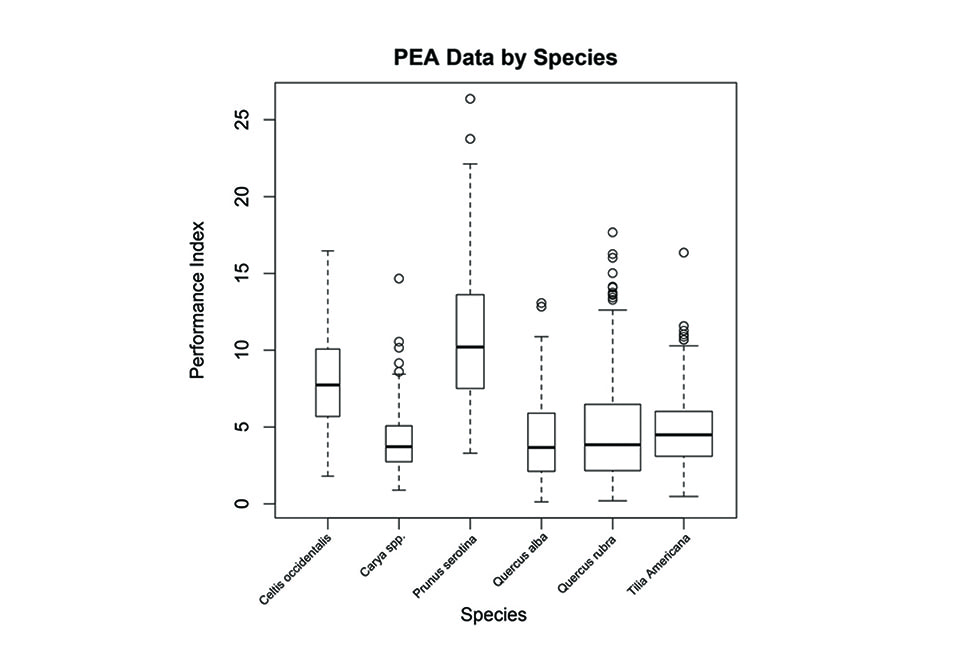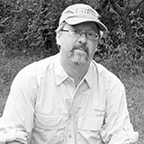The New York City Afforestation Project (NY-CAP) constitutes a new approach to urban ecology that combines scientific research with landscape architecture to advance understanding of constructed urban ecosystems. This approach bridges disciplines through creative partnerships between designers, ecologists, and city agencies to combine hypothesis driven research with public park design. This model produces an urban research platform facilitating experimentation to guide urban forestry, urban design, and land management.
Figure 1. Cities provide opportunities for the invasion of exotics leading to declines in native populations. Within this context, planting a forest composed of natives presents both opportunities and problems. (Image Citation: YALE UEDLAB)
Background
Novel urban ecosystems are increasingly becoming a part of urban sustainable landscapes. As cities go green, a new generation of green and grey infrastructure, as well as other constructed parkland and public spaces are being built to aid in storm water mitigation, pollution removal, carbon sequestration, and biodiversity enhancement. In the creation and restoration of urban landscapes, planting natives is seen as a way to promote native regional biodiversity of plants and animals [1,2]. Other novel ecosystems, such as successional and invasive plant communities, may be less planned but also contribute vital ecosystem services. Continued investment in these projects begs the question: Do they carry out their intended functions? [3] Landscape infrastructure project have the potential to transform the urban landscape, but such projects can also fail to supply the ecosystem services they were designed to provide and may have unintended consequences [4]. The New York City Afforestation Project (NY-CAP) uses an emerging approach in urban ecology, ‘Designed Experiments,’ to answer this question in situ with a research experiment designed as public parkland [5].
Figure 2. NYC and Five Boroughs: New York City is limited in its capacity to increase canopy. (Image Citation: YALE UNIVERSITY UEDLAB)
The New York City Afforestation Project (NY-CAP) an ecological research component of MillionTreesNYC, an initiative launched as part of New York City’s sustainability-driven agenda PLANYC2030 to increase native tree canopy and to promote human and environmental health. The research opportunity for the NY-CAP arose from Mayor Bloomberg’s allocation of US$400 million over 10 years to the New York City Department of Parks and Recreation (NYCDPR) to plant 600,000 trees, including ~800 ha of forest restoration.
This funding enabled a research oriented afforestation project in Kissena Corridor Park in Queens, NY, in which the selected project team proposed to incorporate basic and applied research into the design, going beyond the usual post-implementation monitoring of tree mortality and survival. During project design and implementation, ecologists in the group worked with park managers to develop experiments that would generate new knowledge on the performance and resilience of urban forests. Designers, in turn, incorporated these experiments into an urban aesthetic and functional park design. For the NY-CAP, the designed experiments approach provided a framework for the collaboration of designers and ecologists that allowed each to employ their respective expertise, and at the same time inform and complement each other’s role [6].
The NY-CAP experiments are designed to explore the impact of differences in species richness, vegetative structure and soil amendment on plant performance and survival. The designed experiments approach offers (A) a new platform for ecologists to design and situate hypothesis-driven research in urban areas on sites that have been historically inaccessible to ecological experiments; (B) a new method for generating replicated scientific data about the ecological processes of constructed urban ecosystems; (C) a new framework for connecting ecologists with stakeholders, including city agencies, contractors and park users; and (D) a new means for designers and park maintenance staff to update their underlying assumptions informing urban land management and expand their ecological knowledge.
The construction of this research platform facilitates urban forest research to further understand mechanisms by which the performance and viability of a constructed urban forest are affected by land management practices, initial conditions of the site, as well as human interventions and socio-economic behaviors. The approach embeds applied ecological science into ongoing city planning through a robust and unprecedented study of urban forestry.
Figure 3. The NY-CAP provides multiple values for stakeholders including contributions to evidence-based management, advance sin ecological understanding of constructed ecosystems, the facilitation of novel relationships between ecologists and designers, and opportunities to engage community members and students in the experiment. (Diagram by Yale University UEDLAB)
Challenges to urban afforestation projects
Cities have recently been highlighted as areas of opportunity for the enhancement and conservation of biodiversity [7, 8]. However, cities also provide opportunities for the invasion of exotic species that lead to declines in native populations [9,10,11]. Species invasion is recognized as posing a significant threat to global biodiversity; exotics threaten to homogenize the world’s flora and fauna, displace native species, modify habitats, and alter ecological function [12,13,14]. Understanding these threats, land managers across the world have enacted programs intended to eradicate and mitigate the presence and impacts of exotic species [15]. Notably, urban areas have been highlighted as locations especially susceptible to invasion [16,17,18]. Higher influxes of exotics through transportation, trade, and horticulture have increased species richness in cities but have also displaced native vegetation [19]. Within this context, the decision to plant a forest composed wholly of native species presents both opportunities and problems: Will planted natives survive and outcompete incoming vegetation? Will the original composition persist through successful recruitment of native vegetation? Our research, the New York City Afforestation Project (NY-CAP), seeks answers to these questions, ultimately assessing the sustainability and resilience of a planted native forest [20].
Figure 4. Urbanization alters resources and physical environments, creating rich niche opportunities for exotic species to capitalize upon and putting natives at competitive advantage. The NYC-CAP explores the resiliency of native forests in the face of urban stressors. (Yale University UEDLAB)
As urbanization continues, and human action continues to modify land, novel urban ecosystems are likely to proliferate [21]. Urban areas have recently been highlighted as opportunities for conservation of native species; however, it is important to note that presence is not necessarily a proxy for persistence or sustainability. There has been little research done assessing the resilience and sustainability of native plant species in these novel urban ecosystems [22]. The NY-CAP provides an empirical testing ground to fill this gap in knowledge, enabling the exploration of urban forest resiliency and sustainability. The work is potentially transformative in that it will establish a robust empirical and conceptual framework for asking whether constructed, native, urban ecosystems can persist, by sustaining the planted vegetation through recruitment and resistance to invasive plant species.
Testing Resilience
In order to develop the experiments on forest sustainability in Kissena Corridor Park, we used funds directed towards landscape design and implementation were used both for recreation, green infrastructure, carbon storage and habitat and as part of a well-replicated, large-scale, urban forestry experiment integrated as a component of urban public park design within a densely inhabited city.
The experiments test three central questions: 1) How do urban environmental stressors (i.e. pollution, vandalism, drought) affect the health and survival of planted trees? 2) How does tree health and survival respond to management and planting practices, such as plant diversity and organic amendments? 3) Will planted trees recruit to form the urban forest of the future or will this constructed forest instead be overwhelmed by invasive species? These questions derive from the fact that little data exists on how planted, native vegetation survives and functions in urban settings [23,24,25]. Situating ecological research as a component of green infrastructure presents an opportunity to fill these knowledge gaps.
(Yale University UEDLAB)
The 56 research plots are embedded within public parkland. They are separated into 8 different treatments, consisting of a factorial arrangement of tree species richness (6 species versus 2 species), stand complexity (with shrubs and herbs versus without), and soil amendment (with compost versus without). The research design allows us to determine factors impacting tree survival and seedling recruitment across treatments. To balance the interests of stakeholders (e.g. land managers, park-users, the general public), the NY-CAP was, from the outset, designed to generate useful results for guiding decision making about land management issues.
Figure 5. In the summer of 2011, researchers tracked survival, growth, pest damage, photosynthetic capacity, and drought stress across 1,300 of the planted trees. In summer 2012, researchers tracked seedling recruitment of woody vegetation to determine how incoming vegetation competes with natives. (Yale University UEDLAB)
Measurements include assessing the survival, health, and performance of planted vegetation through a series of metrics including root collar diameter and height, tree vigor, pest incidence, drought stress, and vandalism, specific leaf area, and chlorophyll fluorescence. The research team will track seedling recruitment from natural regeneration through estimates of abundance and survival within the research plots.
Figure 6. This boxplot shows a wide degree of variability between tree species, suggesting that some natives are performing better than others. This information will help inform land managers and other policy makers when implementing large scale plantings in temperate urban areas. (Yale University BRADFORD AND FELSON LABS)
In an environment characterized by pollution, vandalism, drought, pests and disease, it is difficult to say whether or not planted vegetation will survive, persist and be able to recruit its next cohort. The research will test the resiliency and sustainability of this constructed urban forest, applying ecological theory in a constrained urban setting to analyze the survival, growth and recruitment of native species.
Conclusion
“Designed Experiments,” advocate a strong partnership between ecologists and designers through the use of urban design projects as ecological experiments in cities. Expanding the researcher’s role in the design process has the potential to integrate current research into the design and management of the urban built environment and establish a new paradigm for both studying and actively shaping urban ecosystems. There are concerns for limited application of research results to management issues. In confronting these concerns, urban ecological researchers will need to proactively assert the value of ecological sciences, research, and experimentation in urban design projects. To this end, urban ecologists will need to address the broader objective their research will accomplish; namely while basic ecological research seeks to study a system, and design seeks to shape the system, the urban ecology researcher will now have to study a system in order to better shape that system.
The role of designed experiments is not simply to generate statistically viable data but also a multipurpose urban mechanism for revitalization, education and environmental improvement. The design, establishment, and on-going success of the NY-CAP relies on thorough input from a number of stakeholders including, scientists, designers, the New York City Department of Parks and Recreation, as well as local community members. In this way, designed experiments foster collaboration from a number of sources not traditionally involved in ecological research or urban design. Coordinated research and knowledge exchange, advanced data and information sharing, and new research technologies, as well as education and public outreach strategies, are all practices that will support the growth of urban ecology and the integration of ecological principles into the design process, ultimately providing the baseline data and proof-of-concept to implement tested urban sustainability strategies on sites world-wide.
Acknowledgements
The authors would like to acknowledge Robert J. Warren II, Assistant Professor at SUNY Buffalo State and Richard A. Hallett from USDA Forest Service for comments and ideas that contributed to this piece. Thanks to many students from the Urban Ecology and Design Lab, from Mark Bradford’s lab, and from Yale School of Forestry and Yale School of Architecture. Thanks also for funding from Yale’s Hixon Center and Global Institute of Sustainable Forestry. Thanks to the New York City Department of Parks and Recreation, AECOM and the USDA Forest Service for contributions to the project.
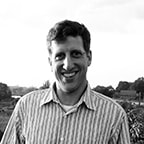 Dr. Alexander Felson is an Assistant Professor at Yale University, where he is jointly appointed between the School of Architecture and the School of Forestry and Environmental Studies. He also directs the joint degree program between these two schools and is the founder of Urban Ecology and Design Lab (UEDLAB). In partnership with The Nature Conservancy, the UEDLAB is developed the Coastal Resilience Plan for Guilford, Connecticut. Dr. Felson is a Co-PI on the NY-CAP project and served as Project Director for AECOM’s work with MillionTreesNYC. Dr. Felson has built bioretention gardens in Bridgeport and is leading Yale’s efforts in a federal HUD and Hurricane Sandy Task Force initiative, Rebuild by Design. His research focuses on linking urban and landscape design with applied ecological research to study, adapt, and reshape human settlements in response to pressing sustainability challenges.
Dr. Alexander Felson is an Assistant Professor at Yale University, where he is jointly appointed between the School of Architecture and the School of Forestry and Environmental Studies. He also directs the joint degree program between these two schools and is the founder of Urban Ecology and Design Lab (UEDLAB). In partnership with The Nature Conservancy, the UEDLAB is developed the Coastal Resilience Plan for Guilford, Connecticut. Dr. Felson is a Co-PI on the NY-CAP project and served as Project Director for AECOM’s work with MillionTreesNYC. Dr. Felson has built bioretention gardens in Bridgeport and is leading Yale’s efforts in a federal HUD and Hurricane Sandy Task Force initiative, Rebuild by Design. His research focuses on linking urban and landscape design with applied ecological research to study, adapt, and reshape human settlements in response to pressing sustainability challenges.
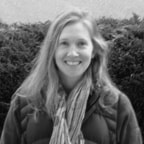 Emily E. Oldfield is a Ph.D. student affiliated with the School of Forestry and Environmental Studies, at Yale University, in New Haven, Connecticut working in Mark Bradford’s Lab and serves as the Project Manager for the New York City Afforestation Project (NY-CAP).
Emily E. Oldfield is a Ph.D. student affiliated with the School of Forestry and Environmental Studies, at Yale University, in New Haven, Connecticut working in Mark Bradford’s Lab and serves as the Project Manager for the New York City Afforestation Project (NY-CAP).
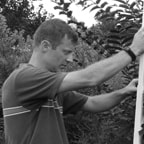 Mark A. Bradford is an Assistant Professor of Terrestrial Ecosystem Ecology at Yale University School of Forestry and Environmental Studies. He is a Co-PI on the NY-CAP project. He is primarily interested in how global change will affect the plants, animals and microorganisms that inhabit terrestrial ecosystems, and what the consequences are for soil carbon stores and cycling. His lab group uses field experiments, field observation, and laboratory studies, focusing across ecosystems in the north and south of the eastern United States. The overall goal of our research is to provide the necessary mechanistic understanding required for reliable prediction of global change impacts on ecosystems, and their likely feedbacks to the climate system.
Mark A. Bradford is an Assistant Professor of Terrestrial Ecosystem Ecology at Yale University School of Forestry and Environmental Studies. He is a Co-PI on the NY-CAP project. He is primarily interested in how global change will affect the plants, animals and microorganisms that inhabit terrestrial ecosystems, and what the consequences are for soil carbon stores and cycling. His lab group uses field experiments, field observation, and laboratory studies, focusing across ecosystems in the north and south of the eastern United States. The overall goal of our research is to provide the necessary mechanistic understanding required for reliable prediction of global change impacts on ecosystems, and their likely feedbacks to the climate system.
Robert Warren is an Assistant Professor of Biology at SUNY Buffalo State. His research focuses on species interactions in a changing climate. His lab group studies how habitat drives individual species distributions, and how habitat drives the interactions between species within and across these distributions. A key assumption is that current species distributions can be, and often are, out of sync with optimal niche requirements. As such, the early recruitment and colonization of native and invasive species is a common them in his lab group.
Notes
[1] M. L. McKinney, “Urbanization as a major cause of biotic homogenization,” Biological Conservation 127 (2006): 247-260.
[2] Karin T. Burghardt, Douglas W. Tallamy, and W. Gregory Shriver. “Impact of native plants on bird and butterfly biodiversity in suburban landscapes.” Conservation Biology 23, no. 1 (2009): 219-224.
[3] K. Thompson and M. A. Davis, “Why research on traits of invasive plants tells us very little,” Trends in Ecology Evolution 26 (2011): 155-156.
[4] D. E. Pataki, M. M. Carreiro, J. Cherrier, N. E. Grulke, V. Jennings, S. Pincetl, R. V. Pouyat, T. H. Whitlow, and W.C. Zipperer, “Coupling biogeochemical cycles in urban environments: ecosystem services, green solutions, and Misconceptions,” Frontiers in Ecology and the Environment 9 (2011): 27-36.
[5] Alexander Felson, MA Bradford, and TM Terway, “Promoting Earth Stewardship through urban designed experiments. Earth Stewardship Special Issue,” Frontiers in Ecology 11 (2013): 362-367, http://dx.doi.org/10.1890/130061
[6] Alexander Felson and S. T. A. Pickett, “Designed experiments: new approaches to studying urban ecosystems,” Frontiers in Ecology and the Environment 3 (2005):549-556, http://dx.doi.org/10.1890/1540-9295(2005)003%5B0549:DENATS%5D2.0.CO;2
[7] R. J. Hobbs, S. Arico, J. Aronson, J. S. Baron, P. Bridgewater, V. A. Cramer, P. R. Epstein, J. J. Ewel, C. A. Klink, A. E. Lugo, D. Norton, D. Ojima, D. M. Richardson, E. W. Sanderson, F. Valladares, M. Vila, R. Zamora, and M. Zobel, “Novel ecosystems: theoretical and management aspects of the new ecological world order,” Global Ecology and Biogeography 15 (2006): 1-7.
[8] I. Kowarik, “Novel urban ecosystems, biodiversity, and conservation” Environmental Pollution 159 (2011): 1974-1983.
[9] J. G. Ehrenfeld, “Invasion of deciduous forest preserves in the New York metropolitan region by Japanese Barberry (Berberis thunbergii DC),” Journal of the Torrey Botanical Society 124 (1997): 210-215.
[10] M. L. McKinney, “Urbanization as a major cause of biotic homogenization,” Biological Conservation 127 (2006): 247-260.
[11] R. L. Vidra, T. H. Shear, and J. M. Stucky, “Effects of vegetation removal on native understory recovery in an exotic-rich urban forest,” Journal of the Torrey Botanical Society 134 (2007): 410-419.
[12] P. M. Vitousek, H. A. Mooney, J. Lubchenco, and J. M. Melillo., “Human Domination of Earth’s Ecosystems,” Science 277 (1997): 494-499.
[13] J. E. Byers, S. Reichard, J. M. Randall, I. M. Parker, C. S. Smith, W. M. Lonsdale, I. A. E. Atkinson, T. R. Seastedt, M. Williamson, E. Chornesky, and D. Hayes, “Directing research to reduce the impacts of nonindigenous species,” Conservation Biology 16 (2002): 630-640.
[14] R. L. Vidra, T. H. Shear, and T. R. Wentworth, “Testing the paradigms of exotic species invasion in urban riparian forests,” Natural Areas Journal 26 (2006): 339-350.
[15] A. D. Kendle and J. E. Rose, ”The aliens have landed! What are the justifications for ‘native only’ policies in landscape plantings?” Landscape and Urban Planning 47 (2000): 19-31.
[16] Hobbs, “Novel Ecosystems: theoretical and management aspects of the new ecological world order,” 1-7.
[17] S. Duguay, F. Eigenbrod, and L. Fahrig, “Effects of surrounding urbanization on non-native flora in small forest Patches,” Landscape Ecology 22 (2007): 589-599.
[18] N. S. G. Williams, M. W. Schwartz, P. A. Vesk, M. A. McCarthy, A. K. Hahs, S. E. Clemants, R. T. Corlett, R. P. Duncan, B. A. Norton, K. Thompson, and M. J. Mcdonnell, “A conceptual framework for predicting the effects of urban Environments on floras,” Journal of Ecology 97 (2009): 4-9.
[19] S. H. Faeth, C. Bang, and S. Saari, “Urban biodiversity: patterns and mechanisms,” Year in Ecology and Conservation Biology (2011): 69-81.
[20] Alexander Felson, MA Bradford, E Oldfiel, “ Involving ecologists in shaping large-scale green infrastructure projects,” Bioscience 63 (2013): 881-890.
[21] Thompson, “Why research on traits of invasive plants tells us very little”, 155-156.
[22] EE Oldfield, RJ Warren, AJ Felson and MA Bradford, “Challenges and future directions in urban afforestation,” Journal of Applied Ecology (2013): 1-9, http://onlinelibrary.wiley.com/doi/10.1111/1365-2664.12124/abstract.
[23] G.R. Robinson and S.N Handel, “Directing spatial patterns of recruitment in an urban woodland restoration,” Ecological Applications 10 (2000): 174-188.
[24] Jeremy Lundholm and Paul Richardson, “Habitat analogues for reconciliation ecology in urban and industrial environments,” Journal of Applied Ecology 47 (2010): 966-975.
[25] Oldfield, “Challenges and future directions in urban afforestation”, 1-9.

